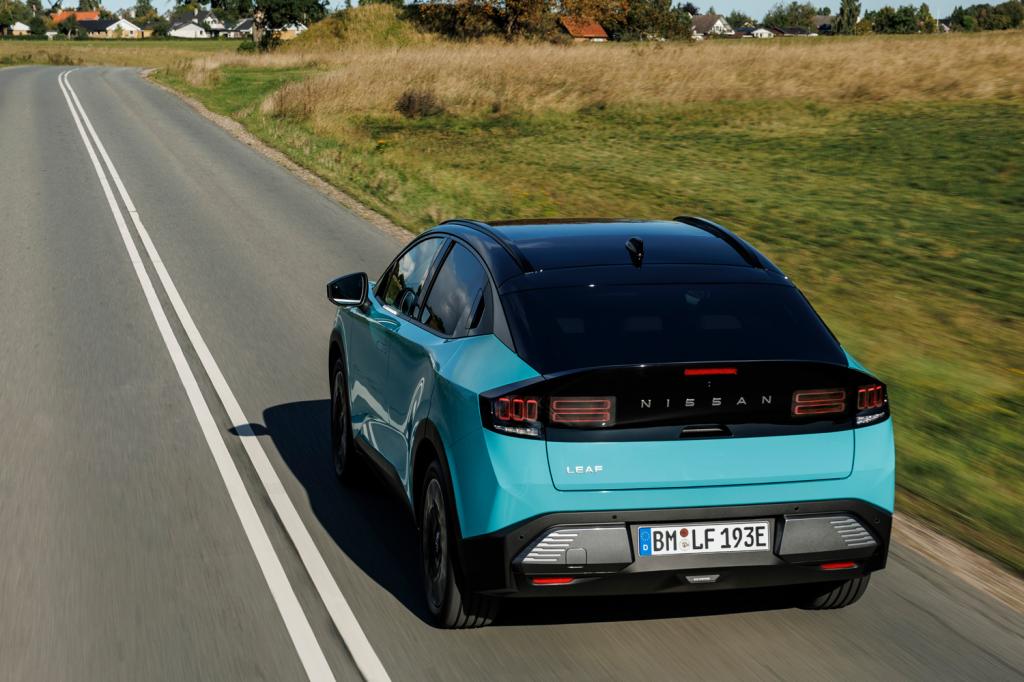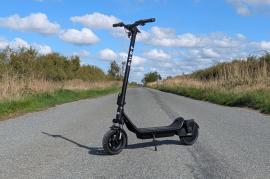I think the new Nissan Leaf kicks range anxiety into touch and it’s pretty cool to look at too
New-found crossover status also brings the Nissan Leaf improved range and practicality

Stuff Verdict
The new Nissan Leaf majors on range and practicality, though the transformation from hatchback to small SUV hasn’t brought an especially inspiring interior along with it.
Pros
- Bigger battery means lots of real-world range
- Sleek design looks good from most angles
- Family-friendly utilitarian interior works
Cons
- Some interior touches feel dated
- Feels a bit interchangeable with rivals
- Infotainment good rather than great
Introduction
Not long ago I was parked at a charging station and the guy next to me was charging an original Nissan Leaf. He said its range was, well, largely hopeless. Close-to-home shopping trips was all the affordable EV was really cut out for and, he added with a sigh, the lengthy excursion he was currently on had already involved four stops to recharge. Not so with the new Nissan Leaf, which boasts a range of up to 386 miles, supplemented by 150kW rapid charging capability.
Yup, the Nissan Leaf has come a long way and since its inception way back in 2011. To be fair, Nissan were rather ahead of the game back then, but the updates to the Leaf since, whilst good, have been rather bypassed by rivals from Korea and China. Nissan’s designers and engineers have been working hard though, and the result is an all-new crossover car that is not only very practical but looks cool too.
There are two models heading for the UK, with 52kWh battery model costing from £33,000 and a larger 75kWh model, as tested here, that has a price tag of £36,000 – though Nissan hopes the SUV will qualify for the UK’s Electric Car Grant, which could shave £3,750 off the cost. And, in other positive UK-focused news, the latest Leaf will be built at Nissan’s Sunderland plant, although it was designed in Japan. Pick around the car and that inherently Japanese flavouring comes through. After quite a lot of picking, I think I like it.
The styling











The design of the new Nissan Leaf definitely works and even more so when it’s presented in the launch colour of Luminous Teal. It’s a modern colour for a bang-up-to-date design. Curiously though, I kept on feeling like the rear end was reminding me of a cocktail of 1990s Japanese metal, although I still can’t quite put my finger on one specific car. There’s a strange whiff of retro coming from that back end to my mind, though. Maybe it’s just me, huh?
Elsewhere, the Nissan Leaf blends a very aerodynamic design with practicality. The sloping rear roofline led me to expect the rear to be a bit cramped, but there was plenty of headroom. Spacious-ness is less great around the footwell though and when the front passenger seat was just halfway adjusted, I thought it was hard to find much room for my feet when sitting in the back.
Nissan softens the blow with a beefy middle armrest, although I thought the seats felt quite unforgiving too, even though the light-coloured trim looked like it would be hardwearing enough for everyday family use. That being said, the pale synthetic, leathery-esque finish could pick up marks and scuffs quite easily I would think.
You get 437 litres of space in the boot, with a lower section available underneath the regular floor panel. The slope of the tailgate might produce problems with bulkier items, although the seats can be reworked to cope with less-than-average loads. The interior as a whole felt quite light and bright, which was helped in my car by a dimming panoramic roof as has already been seen in some closely related Renault models.
The drive





I was expecting the Nissan Leaf, based on the dedicated front-wheel drive, CMF-EV platform, to offer a slightly by-numbers driving experience, but it’s a deliciously sprightly thing in the bigger battery format that has some muscle. However, the trade-off is the tinge of body roll that comes from something reasonably high off the ground. At up to 1946kg, depending on the model variant, the Leaf does feel quite heavy too, so at full pelt the 4.35 metre body does make it quite hefty.
Nevertheless, like most other EVs, the Nissan Leaf is a doddle to drive. Mirrors are easily managed thanks to physical controls in the door and the electric seat allowed for easy positioning. I thought the steering wheel felt a bit oddly placed though, as if seemed like it was slightly off kilter, but I think that may have been an effect produced by the digital dashboard and infotainment panels. The steering wheel also contains some pronounced physical buttons, which are good but look like they could have come out of an older car.
No matter. Overall, I thought the Nissan Leaf performed well across a range of roads and driving conditions. There was very little road noise from the tyres, although some wind buffeting from around the mirrors and doors at higher speeds. Around town, the Nissan Leaf is dextrous and feels very capable, both when parking and getting in and out of junctions. It’s swift off at the lights and Nissan’s iPedal is still as good as it’s always been for anyone, including me, keen on one-pedal driving.
Motorway miles seemed quite kind to the Nissan Leaf’s powertrain too, with the Japanese carmaker quoting an estimated 269 miles for highway motoring. The 4.5 miles per kWh stated in the stats seemed a little bit ambitious, but I was pushing the car most of the time and also had Sport mode on a lot. Nissan’s 0.25 drag coefficient for the Leaf is probably what will keep the figure impressively high subject to homologation. With a 0-62mph time of 7.8 seconds (7.6 seconds in Sport) this chunky crossover SUV feels fast enough, topped off with a 99-mph top speed.
The technology






Earlier Nissan Leaf models really did feel dated when it came to their interior and tech features. The Japanese carmaker has attempted to address this frequently made point by delivering a fresh take. It works on most levels, with the most dominant area being the twin 14.3in screens that sit along the top of the dashboard. The steering wheel controls still look oddly retro, although I did like the way their raised profile proved very practical when on the move.
Nissan offers additional vehicle controls via its NissanConnect Services app, while most of the options sit within the touchscreen area. This felt responsive enough for daily use, although the sat-nav was annoyingly slow on occasions, usually when it was needed at a last-minute deviation or junction. Although the installed Google Maps will work for most, I’m increasingly keen on plugging in my own options via either Apple CarPlay or Android Auto connectivity. Wireless phone charging helped me when I did.
Anyone who enjoys driving assistants will find the Nissan ProPilot Assist suite of options as good as it’s always been. Plus, there’s a quick and easy route that involves a couple of button pushes for taking away irritating audio warnings. I was also impressed by the 3D Around View Monitor that delivered an eight-point perspective right around the car on-screen. A definite boon when getting into tightly packed town spaces.
Nissan Leaf verdict

I liked the Nissan Leaf and it’s a complete package, with range and practicality being the two main factors that might persuade me to buy one over the many rivals out there. The only issue being there’s no major wow factor with even the design proving to be good rather than great. The same goes for the Google-driven infotainment system. It was all very usable, but I have other current favourites and most of them are Korean. Everything works, but there’s no dazzle factor.
Nissan’s designers have done their best by incorporating a few funky little design tweaks on the Leaf and spent time pointing out not very well hidden easter eggs around the car. I think I’d like to see the car in some of the zingier paint schemes being offered by Nissan as part of the new paint and trim collection, which might lift the Leaf to loftier heights. As it stands though, whilst being perfectly alright, it’s a wee bit on the generic side.
Stuff Says…
The new Nissan Leaf majors on range and practicality, though the transformation from hatchback to small SUV hasn’t brought an especially inspiring interior along with it.
Pros
Bigger battery means lots of real-world range
Sleek design looks good from most angles
Family-friendly utilitarian interior works
Cons
Some interior touches feel dated
Feels a bit interchangeable with rivals
Infotainment good rather than great
Nissan Leaf technical specifications
| Powertrain | Permanent magnet synchronous motor |
| Battery75 | 75kW |
| Power | 215bhp |
| Torque | 262lb ft |
| 0-60mph | 7.8sec |
| Top speed | 99mph |
| Range | 386 miles |
| Charge rate | 150kWh |
| Cargo volume | 437 litres |



